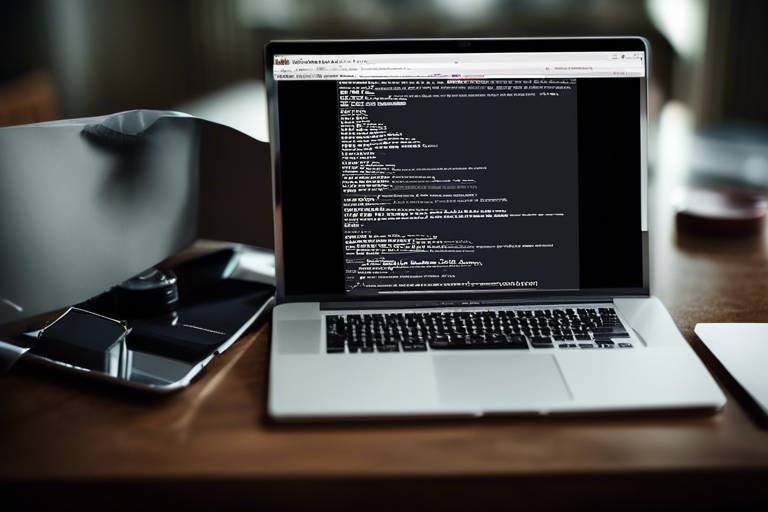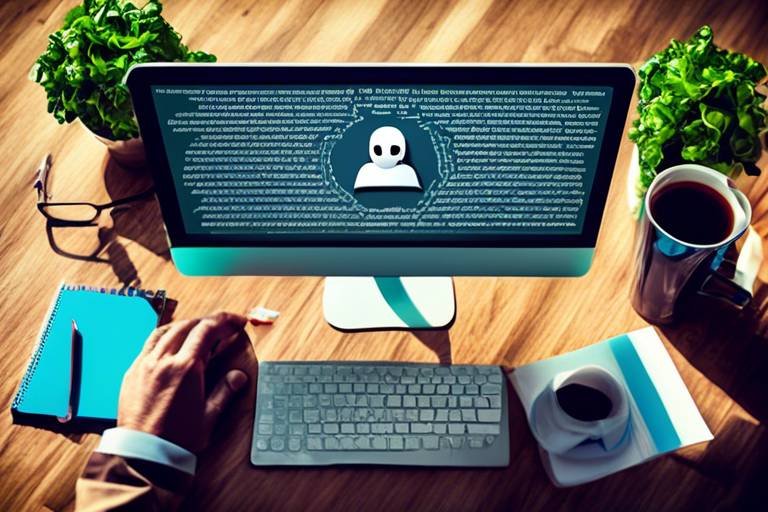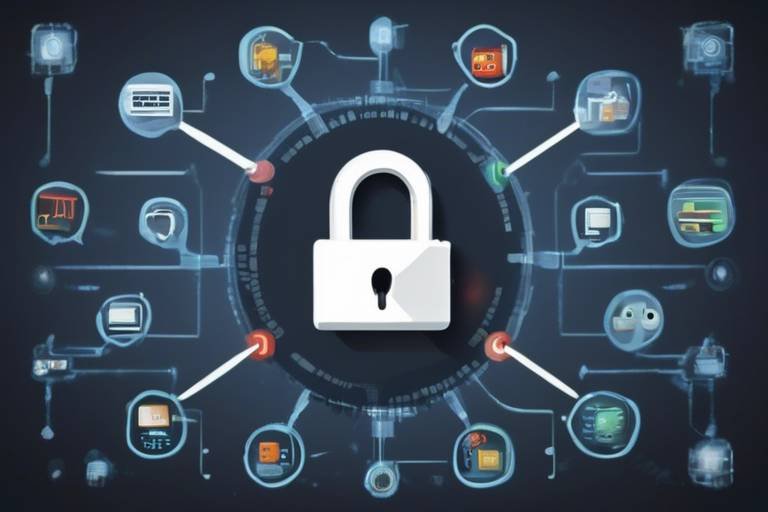How to Spot Fake Software and Updates
In today's digital landscape, where our devices are constantly connected to the internet, the risk of encountering fake software and updates is alarmingly high. With cyber threats lurking around every corner, it's essential to arm yourself with the knowledge to identify counterfeit software. This article provides essential tips and strategies to identify counterfeit software and updates, ensuring that your devices remain secure and functional while avoiding potential threats from malicious programs. Think of spotting fake software as a game of detective; you need to be observant and know what clues to look for. So, let’s dive into the world of software authenticity and learn how to keep your digital life safe!
The first step in protecting yourself is knowing the red flags that signal potential threats. Fake software often comes with unusual prompts that seem out of place, such as unexpected requests for personal information or strange installation processes. Additionally, be wary of software that originates from unfamiliar sources. If you’ve never heard of the publisher or the website seems sketchy, it’s a good idea to investigate further. Some common warning signs to watch out for include:
- Unusual prompts: Requests for sensitive information or permissions that don’t align with the software’s purpose.
- Unverified publishers: Software from companies or developers with no established reputation.
- Too-good-to-be-true offers: Free versions of premium software that usually come with hidden dangers.
Once you’ve spotted potential red flags, it’s time to dig deeper into verifying the software's authenticity. One effective method is to check for digital signatures. These signatures confirm that the software has not been altered since it was published. By comparing hashes, you can ensure that the software you downloaded matches the original version. This is crucial for maintaining the integrity of your system. Always utilize official websites for downloads to minimize the risk of encountering counterfeit software.
Digital signatures play a vital role in validating software authenticity. They act as a digital fingerprint, ensuring that the program you’re about to install is exactly as the publisher intended. When you see a software package with a valid digital signature, it’s a strong indication that it’s safe to proceed. Think of it like a seal of approval from the software developer, confirming that the file hasn’t been tampered with since it was created.
Verifying digital signatures is easier than you might think! Most operating systems come with built-in tools that allow you to check a software’s signature. Here’s a quick guide:
- Right-click on the software file and select Properties.
- Navigate to the Digital Signatures tab.
- Select the signature and click Details to view the signature information.
- Check if the signature is valid and if it matches the publisher’s name.
Downloading software from reputable sources is critical in avoiding fake software. Trusted platforms often have strict guidelines and vetting processes for the software they host. When you stick to well-known websites, you significantly reduce your risk of downloading counterfeit programs. Always prioritize official channels over third-party sites, as they are more likely to provide safe, legitimate software.
Another layer of defense against fake software is using reliable antivirus software. These programs are designed to detect and block malicious software, including counterfeit applications. Regularly updating your antivirus software ensures it recognizes the latest threats, keeping your devices secure. Think of it as having a security guard for your digital life, watching out for any suspicious activity.
Before hitting that download button, take a moment to conduct thorough research. Reading user reviews can provide valuable insights into the software’s credibility. Look for patterns in feedback; if multiple users report issues, it’s a red flag. Be aware of fake reviews that may mislead you. Often, these can be identified by overly positive language or a lack of detail about the user experience.
User reviews are a treasure trove of information when assessing software credibility. They can help you gauge the software’s performance and reliability. However, be vigilant about spotting fake reviews. If a review seems too generic or overly enthusiastic without specifics, it could be a sign that it’s not genuine. Always look for reviews that provide a balanced view, highlighting both pros and cons.
Investigating a software developer's reputation is crucial. Look into their history, customer service track record, and previous software releases. A reputable developer will usually have a solid online presence, including a professional website and active social media accounts. If you can’t find any information about the developer, it’s best to steer clear of their software.
Staying informed about software releases and updates from trusted sources is essential to avoid falling prey to counterfeit versions. Regularly check for updates from official channels to ensure you’re using the latest and most secure versions of your software. This vigilance can save you from potential headaches down the line.
To ensure you receive legitimate and secure versions of software, always follow official communication channels for updates. This includes subscribing to newsletters from the software provider, following their social media accounts, and regularly checking their website for announcements. By doing so, you’ll be the first to know about genuine updates and new releases.
Finally, it’s crucial to differentiate between legitimate and fake update notifications. Genuine alerts typically come directly from the software itself or the official website. Be skeptical of unsolicited notifications that pop up unexpectedly, especially if they ask you to install something immediately. Always verify through official channels before taking any action.
Q: How can I tell if a software is fake?
A: Look for red flags such as unusual prompts, unfamiliar sources, and unverified publishers. Always check for digital signatures and download from trusted platforms.
Q: What should I do if I suspect I have downloaded fake software?
A: Uninstall the software immediately, run a full system scan with your antivirus software, and consider restoring your system to a previous state if necessary.
Q: Are there any tools to help verify software authenticity?
A: Yes, you can use built-in operating system tools to check digital signatures, as well as third-party software specifically designed for this purpose.

Recognizing Red Flags
When it comes to identifying fake software and updates, being aware of the red flags is your first line of defense. Just like a seasoned detective, you need to sharpen your instincts and look for signs that something might be off. One of the most common indicators is unusual prompts. If a software installation asks you to grant permissions that seem excessive, like accessing your camera or microphone when it shouldn't, it's a clear warning sign. Think of it as a stranger asking for your house keys; would you hand them over without a second thought?
Another crucial red flag is unfamiliar sources. If you stumble upon software or updates from a website you’ve never heard of, proceed with caution. Always remember that legitimate software is typically available through well-known platforms or the official website of the developer. It's like shopping for groceries; you wouldn’t buy produce from a vendor you’ve never seen before, right? The same logic applies to downloading software.
Furthermore, keep an eye out for unverified publishers. If the software is being offered by a publisher with little to no online presence, it’s wise to be skeptical. Look for reviews, testimonials, or any evidence that supports the credibility of the publisher. If you can't find any, it’s like trying to trust a restaurant that has no customers—something just doesn't add up!
Additionally, be cautious of too-good-to-be-true offers. If a software claims to provide premium features for free or at an unbelievably low price, it might be a bait to lure you into downloading malicious software. Just like a flashy advertisement for a luxury car at a suspiciously low price, it’s essential to ask yourself, “What’s the catch?”
Finally, always be wary of unsolicited messages or emails offering software updates. If you receive a notification out of the blue, especially if it contains links or attachments, it’s best to ignore it. Trust your gut; if it feels fishy, it probably is! In summary, recognizing these red flags can save you from potential headaches and keep your devices secure. Stay vigilant and always question the legitimacy of what you download.
Q: What should I do if I suspect I've downloaded fake software?
A: If you suspect that you've downloaded fake software, immediately uninstall it from your device. Run a full system scan using reputable antivirus software to ensure that no malicious files remain. Additionally, consider changing your passwords and monitoring your accounts for any unusual activity.
Q: Are there any specific websites I can trust for downloading software?
A: Yes, always download software from official websites or trusted platforms such as Microsoft Store, Apple App Store, or well-known software distribution sites like CNET or Softpedia. These platforms usually vet the software they host.
Q: How can I tell if a software update is legitimate?
A: To determine if a software update is legitimate, check for notifications directly from the software itself or visit the official website of the developer. Avoid clicking on links in unsolicited emails or messages.
Q: What are digital signatures and why are they important?
A: Digital signatures are a way to verify the authenticity of software. They ensure that the software has not been altered since it was published. Always check for digital signatures, especially for critical software.

Checking Software Authenticity
When it comes to ensuring the security of your devices, checking the authenticity of software is paramount. In today's digital landscape, where counterfeit software is rampant, knowing how to verify the legitimacy of the programs you install can save you from a world of trouble. It's like having a trusted friend who always gives you the best advice before you make a big decision. So, how do you make sure that the software you’re about to download is the real deal?
First off, one of the most effective methods is to check for digital signatures. Digital signatures act like a digital fingerprint for software, confirming that it has not been altered since it was published. Think of it as a seal of approval from the software creator. If a program has a valid digital signature, it indicates that the software is genuine and has been verified by the publisher. But how do you go about verifying these signatures? Well, it’s easier than you might think!
Digital signatures utilize cryptographic techniques to ensure that the software you are downloading is authentic. When a developer creates software, they can sign it with a digital certificate, which is issued by a trusted certificate authority. This signature not only verifies the source but also ensures that the software hasn’t been tampered with since it was signed. Imagine receiving a letter sealed with wax; that seal assures you that the contents haven’t been meddled with. Similarly, digital signatures provide that assurance in the digital realm.
To verify digital signatures, you can use built-in tools that come with your operating system. For instance, on Windows, simply right-click the file, select Properties, and navigate to the Digital Signatures tab. Here, you can see if the signature is valid and who the publisher is. If you’re using a Mac, you can utilize the Keychain Access application to check the validity of the digital signatures. Alternatively, third-party software tools are also available that can help you in this process. Just remember, if the signature doesn’t match the expected publisher, it’s a red flag.
Downloading software from reputable sources is crucial in avoiding counterfeit versions. Stick to official websites or recognized platforms such as Microsoft Store, Apple App Store, or Google Play Store. These platforms have strict guidelines for software developers and often perform their own checks to ensure authenticity. If you come across software on an obscure website, it’s best to proceed with caution. Think of it like buying a watch; would you trust a street vendor or a reputable jeweler? Always choose the latter!
In conclusion, checking software authenticity is not just about avoiding a bad experience; it’s about protecting your personal data and ensuring your devices run smoothly. By understanding digital signatures, verifying them correctly, and downloading from trusted sources, you can significantly reduce the risk of falling victim to counterfeit software. Remember, being proactive today can save you from headaches tomorrow!
Q: What is a digital signature?
A: A digital signature is a cryptographic technique used to validate the authenticity and integrity of software. It ensures that the software has not been altered since it was signed by the publisher.
Q: How can I tell if a software source is reputable?
A: Look for official websites or recognized platforms like the Microsoft Store or Apple App Store. Check for user reviews and ratings as well.
Q: What should I do if I suspect that software is counterfeit?
A: Do not install the software. Instead, research further, check for digital signatures, and consider reaching out to the publisher for verification.

Understanding Digital Signatures
Digital signatures are a crucial element in the world of software authenticity and security. They serve as a virtual fingerprint for software, ensuring that the program you are about to install is indeed what it claims to be. Imagine receiving a letter from a friend, but instead of their signature, you see a scribble that looks nothing like their handwriting. Would you trust that letter? Similarly, digital signatures provide a way to verify that the software has not been tampered with since its creation, much like a trusted signature on an important document.
When software is developed, the developer uses a cryptographic algorithm to create a unique signature based on the software's content. This signature is then attached to the software package. When you download the software, your system can check this signature against the original to confirm its integrity. If the software has been altered in any way, the signature will not match, alerting you to potential risks. This process is vital in protecting your devices from malicious software that can compromise your personal data and system functionality.
In addition to confirming authenticity, digital signatures also help you verify the identity of the publisher. When you see a digital signature, you can check the certificate authority that issued it, ensuring that it comes from a reputable source. This is especially important in an age where cyber threats are rampant and counterfeit software can easily slip through the cracks.
To better understand how digital signatures work, here’s a simplified breakdown:
| Step | Description |
|---|---|
| 1 | The developer creates the software and generates a hash of its contents. |
| 2 | The developer encrypts the hash with their private key, creating the digital signature. |
| 3 | The software package is distributed along with the digital signature. |
| 4 | Upon downloading, your system decrypts the signature using the developer's public key and compares the hash. |
| 5 | If the hashes match, the software is verified as authentic; if not, it may be compromised. |
Understanding digital signatures is essential for anyone who downloads software or updates. They provide a layer of trust in an otherwise uncertain digital landscape. So, the next time you're about to install a new program, take a moment to check for that digital signature. It’s a small step that can save you from significant headaches down the line.
- What is a digital signature? A digital signature is a cryptographic technique used to validate the authenticity and integrity of a message or software.
- How can I verify a digital signature? You can verify a digital signature using built-in tools in your operating system or third-party software designed for this purpose.
- Why are digital signatures important? They ensure that the software has not been altered and confirm the identity of the publisher, protecting users from malicious software.

How to Verify Signatures
Verifying digital signatures is a crucial step in ensuring the authenticity of software before you install it on your device. Just like checking the seal on a letter, a digital signature acts as a guarantee that the software you’re about to download hasn’t been tampered with since it was published. But how do you go about verifying these signatures? It’s easier than you might think! Here are some steps you can follow:
First, you will want to locate the digital signature of the software. This is typically found in the properties of the executable file. To do this, right-click on the file and select Properties. From there, navigate to the Digital Signatures tab. Here, you will see a list of signatures that are associated with the file. Click on the signature to view details about it.
Next, you’ll want to check the details of the signature. Look for the name of the signer, which should be a reputable company or individual. If the name seems unfamiliar or suspicious, it’s a red flag. Additionally, check the timestamp of the signature. A valid signature should have a timestamp indicating that it was signed before the software was made available for download.
To ensure that the signature is still valid, you can click on the Details button in the Digital Signatures tab. This will allow you to see if the signature is valid. If it’s not, you’ll receive a warning that the signature is either invalid or the certificate has expired. This can happen if the software hasn’t been updated in a long time, so proceed with caution.
Furthermore, if you're using Windows, you can utilize built-in tools to verify signatures. For instance, the signtool is a command-line utility that can be used to verify the digital signature of a file. Simply open the Command Prompt and type the following command:
signtool verify /pa /v "path_to_your_file.exe"
Replace path_to_your_file.exe with the actual path of the file you want to verify. The tool will provide you with a detailed report on the signature's validity, enhancing your confidence in the software's authenticity.
Lastly, if you're ever in doubt, you can cross-reference the software with the official website or trusted repositories. Many developers provide checksums (hash values) for their files, allowing you to compare your downloaded file against the original. This way, you can ensure that the software hasn’t been altered in any way.
In summary, verifying digital signatures is a vital practice that can save you from potential malware and security threats. By following the steps outlined above, you can confidently download and install software, knowing that it’s legitimate and safe to use.
- What is a digital signature?
A digital signature is a cryptographic technique that validates the authenticity and integrity of a message or software. It ensures that the software has not been altered and confirms the identity of the publisher. - How can I tell if a software is safe to download?
Always download software from official websites or trusted platforms. Verify digital signatures, read user reviews, and check for any red flags before proceeding with the installation. - What should I do if the digital signature is invalid?
If the digital signature is invalid, it’s best to avoid installing the software. An invalid signature may indicate that the software has been tampered with or is not from a legitimate source.

Importance of Trusted Sources
When it comes to downloading software, the source is everything. Imagine walking into a store and finding a product that looks appealing but lacks any brand name or quality assurance. Would you buy it? Probably not! The same principle applies to software. Downloading from trusted sources is crucial in ensuring that the software you install is both legitimate and secure. Trusted sources are typically well-known platforms that have built a reputation for providing authentic software, such as official websites or established app stores.
Why does this matter? Well, counterfeit software often comes bundled with malware or other harmful components that can wreak havoc on your system. By sticking to reputable sources, you minimize the risk of exposing your device to these threats. For instance, platforms like the Microsoft Store, Apple App Store, or Google Play Store have strict guidelines and security measures in place to verify the authenticity of the software they offer. This means that when you download an application from these platforms, you can be more confident that it has been vetted for safety.
Furthermore, trusted sources often provide support and updates for their software. This means that if you encounter any issues or need help, you can rely on their customer service. In contrast, downloading from unverified sources can leave you stranded without any assistance if something goes wrong. It's like buying a car without a warranty—sure, it might look great, but if the engine fails, you're on your own!
To help you identify trusted sources, here are some tips:
- Always check for SSL certificates on websites. A secure site will have "https://" in the URL.
- Look for user reviews and ratings on the platform. High ratings and positive feedback are good indicators of reliability.
- Research the developer behind the software. Established companies are more likely to provide legitimate products.
By following these guidelines and prioritizing trusted sources, you can significantly reduce the chances of downloading fake software. Remember, a little caution can go a long way in protecting your devices and personal information from potential threats.
Q: What are some signs that a software source is not trustworthy?
A: Look out for poorly designed websites, lack of contact information, and excessive pop-up ads. If the site seems unprofessional, it's best to avoid it.
Q: Can I trust free software?
A: Not all free software is bad, but it's essential to do your research. Many reputable companies offer free versions, but always check the source.
Q: How can I ensure that my antivirus software is up to date?
A: Most antivirus programs have an automatic update feature. Make sure this is enabled, and periodically check for updates manually to ensure maximum protection.

Utilizing Antivirus Software
In today's digital landscape, where threats lurk around every corner, utilizing antivirus software is not just a good idea; it's a necessity. Think of antivirus software as your personal digital bodyguard, on constant alert for any suspicious activity that could compromise your system. With the rise of counterfeit software and malicious updates, having a robust antivirus solution can significantly reduce your risk of falling victim to these threats.
Antivirus software works by scanning your system for known malware signatures and suspicious behaviors. When you download software or updates, your antivirus program automatically checks them against its database of known threats. If it detects anything unusual, it can either quarantine the file or alert you to take action. This proactive approach is essential because many counterfeit programs are designed to look legitimate, making them difficult to spot with the naked eye.
But how do you choose the right antivirus software? Not all antivirus programs are created equal. Here are a few factors to consider:
- Detection Rates: Look for antivirus solutions with high detection rates for known malware.
- Real-Time Protection: Ensure the software offers real-time scanning to catch threats as they appear.
- User-Friendly Interface: A simple and intuitive interface can make managing your security much easier.
- Regular Updates: Choose software that updates its virus definitions regularly to stay ahead of new threats.
Moreover, many antivirus programs come equipped with additional features that enhance your security beyond simple malware detection. For example, some offer firewall protection, which acts as a barrier between your computer and potential threats from the internet. Others include features like web protection, which can block access to known malicious sites, and email scanning, which checks attachments and links in your emails for potential threats.
It’s also important to remember that no antivirus software can guarantee 100% protection. Cyber threats are constantly evolving, and new malware is created every day. Therefore, it’s essential to combine antivirus software with safe browsing habits and regular software updates. Always be cautious when downloading files or clicking on links, especially from unfamiliar sources. Even the best antivirus can only do so much if you’re not vigilant.
In summary, utilizing antivirus software is a crucial step in safeguarding your devices against fake software and updates. By choosing a reputable antivirus solution and staying informed about the latest threats, you can significantly reduce your risk of encountering malicious programs. Remember, your digital safety is in your hands, and taking proactive measures is the best way to ensure a secure online experience.
1. What is antivirus software?
Antivirus software is a program designed to detect, prevent, and remove malware from your computer. It scans files and programs for known threats and helps protect your system from potential harm.
2. How often should I update my antivirus software?
It's recommended to keep your antivirus software updated at all times. Most antivirus programs automatically update their virus definitions, but you should also check for software updates regularly.
3. Can antivirus software protect me from all threats?
While antivirus software provides a significant layer of protection, it cannot guarantee complete safety. It's important to practice safe browsing habits and remain cautious about downloading files from unknown sources.
4. Do I need antivirus software if I have a firewall?
Yes, both antivirus software and a firewall serve different purposes and work together to enhance your security. A firewall protects your system from unauthorized access, while antivirus software detects and removes malware.
5. Is free antivirus software effective?
Free antivirus software can offer basic protection, but it may lack advanced features found in paid versions. If you want comprehensive protection, consider investing in a reputable paid antivirus solution.

Researching Software Before Downloading
In today's digital age, is more crucial than ever. With the rise of counterfeit software and malicious updates, taking the time to ensure that what you're about to install is legitimate can save you a lot of headaches down the line. Imagine walking into a store and picking up a product without checking its label; you wouldn't do that with a physical item, so why do it with software? By following a few simple steps, you can protect your devices and personal information from potential threats.
First and foremost, it's essential to read user reviews. These reviews can provide valuable insights into the software's functionality and reliability. However, be cautious! Not all reviews are created equal. Some may be fabricated to mislead you into thinking a product is better than it actually is. Look for reviews that are detailed and provide specific information about the software's performance. A mix of positive and negative reviews is often a good indicator of authenticity, as fake reviews tend to be overly glowing or suspiciously vague.
Another vital aspect of your research should be checking the developer's reputation. A reputable developer will have a history of creating quality software and will often have a dedicated customer service team to assist users. Look for information about the developer on their official website and third-party platforms. You can also check forums and tech blogs for feedback from other users. A developer with a history of frequent updates and a good response to customer issues is typically a reliable choice.
Don't forget to verify the software's presence on official websites. Downloading from the developer's site or well-known platforms like Microsoft Store or Apple App Store significantly reduces the risk of downloading counterfeit software. If you come across a download link from an unfamiliar site, it's best to proceed with caution. You can always use a search engine to find the official page of the software you want. This extra step ensures you're getting the genuine product.
Lastly, consider creating a checklist to guide your research process. Here’s a simple example:
| Research Step | Details |
|---|---|
| Read User Reviews | Look for detailed feedback and a mix of opinions. |
| Check Developer Reputation | Investigate the developer's history and customer service. |
| Download from Official Sources | Use the developer's website or trusted platforms. |
By taking these steps, you can significantly reduce the risk of downloading fake software and ensure that you are investing your time and resources into something that will genuinely benefit you. Remember, a little research goes a long way in keeping your devices secure!
- How can I tell if a software review is fake? Look for specific details and a balanced view. Fake reviews often lack depth and are overly positive.
- Is it safe to download software from third-party websites? While some third-party sites may be trustworthy, it's always safer to download from official sources.
- What should I do if I suspect I've downloaded fake software? Uninstall it immediately and run a full antivirus scan on your device.

Reading User Reviews
When it comes to assessing the credibility of software, user reviews can be a treasure trove of information. Think of them as the collective voice of experience, sharing insights that can either bolster your confidence in a product or send you running for the hills. But how do you sift through the noise to find the gems? First, look for reviews that provide detailed feedback rather than vague comments. A review that outlines specific features, performance, and even issues encountered is far more valuable than a simple "This software is great!"
Moreover, be wary of fake reviews. Unfortunately, some developers resort to manipulating reviews to create a false sense of credibility. To spot these, pay attention to patterns. For instance, if you see numerous reviews posted in a short timeframe, especially if they use similar language or phrases, it's a red flag. Additionally, consider the balance of the reviews. A product with overwhelmingly positive feedback, yet no critical voices, might indicate that something is amiss.
Another strategy is to check the profile of the reviewers. Are they verified users? Do they have a history of reviewing multiple products? Authentic reviewers often share their experiences across various platforms, which adds credibility to their opinions. If a review seems overly enthusiastic or is filled with technical jargon that doesn't align with the software's purpose, it might be worth questioning its authenticity.
Finally, don't just rely on one source for reviews. Cross-reference opinions from different platforms such as forums, tech blogs, and social media. This broader perspective can help you build a more comprehensive understanding of the software in question. In essence, reading user reviews is not just about gathering opinions; it's about piecing together a puzzle to see the full picture before making your download decision.
- How can I identify fake user reviews? Look for patterns in review timing, overly generic language, and a lack of detailed feedback.
- Are all reviews trustworthy? No, it's essential to consider the reviewer's profile and cross-reference opinions from multiple sources.
- What should I look for in a good review? Detailed insights about the software's features, performance, and any encountered issues are key indicators of a credible review.

Checking Developer Reputation
When it comes to downloading software, one of the most crucial steps is checking the developer's reputation. Think of it like meeting someone new; you wouldn’t just trust anyone without knowing a bit about them, right? The same principle applies here. A reputable developer is more likely to produce reliable and safe software, while a dubious one could potentially expose you to malware or other security threats. So, how do you go about assessing a developer's credibility? Let's break it down.
First, start by doing a quick online search. Look for reviews and articles that mention the developer. Are they known in the industry? Do they have a history of creating reliable software? You might be surprised at what you can find with just a few clicks. Additionally, check for any user feedback on forums or social media platforms. If a developer has a significant number of complaints or negative reviews, it’s a red flag.
Another aspect to consider is the developer's history. Have they been around for a while, or are they a new player in the game? Established developers often have a track record that you can follow. For instance, they might have released several successful products, maintained consistent updates, or provided good customer support in the past. You can also check if they have any partnerships with well-known companies or organizations, which can further validate their credibility.
Moreover, take a look at their customer service. A reputable developer should have multiple channels for customer support, such as email, chat, or phone. If they’re hard to reach or unresponsive, that’s another warning sign. You might want to check their response times and how they handle complaints. A developer that values its users will be transparent and willing to assist.
Lastly, consider checking for any certifications or awards that the developer may have received. These accolades can serve as a testament to their commitment to quality and security. You can often find this information on their official website. Just remember to verify these claims through independent sources to ensure they are legitimate.
In summary, checking a software developer's reputation is a vital step in ensuring the safety of your devices. By conducting thorough research and considering factors like user feedback, history, customer service, and certifications, you can make a more informed decision. Remember, when it comes to software, it’s always better to be safe than sorry!
- How can I find user reviews for a software developer?
You can check tech forums, software review sites, and social media platforms. Websites like Capterra or G2 Crowd often provide user feedback. - What should I do if I find negative reviews about a developer?
Assess the nature of the complaints. If they are consistent and serious, it might be wise to avoid that developer. - Are certifications important for software developers?
Yes, certifications can indicate a developer's commitment to quality and security standards. - How can I verify a developer's history?
Look for their previous software releases, check for news articles, and see how long they have been in business.

Staying Informed About Updates
In today's digital landscape, keeping your software updated is not just a good practice; it's a necessity. With the proliferation of cyber threats and counterfeit software, staying informed about updates from trusted sources can be the difference between a secure system and a compromised one. So, how do you ensure that you’re always in the loop? First and foremost, it’s essential to follow the official channels of the software you use. This could mean subscribing to newsletters, following their social media accounts, or even joining community forums where updates are frequently discussed. By doing this, you not only receive notifications about the latest versions but also gain insights into any potential issues that other users might be experiencing.
Moreover, understanding the significance of update notifications is crucial. Legitimate updates often come with clear communication from the developers, detailing what changes have been made and why they are important. In contrast, fake notifications can be vague or overly alarming, often prompting you to click on suspicious links. It’s essential to differentiate between the two. For instance, if you receive a pop-up urging you to update your software but you haven’t initiated any action, it’s a red flag. Always verify such notifications by checking the official website or your software’s update feature directly.
Additionally, consider setting up alerts for major software releases or updates. Many software companies provide ways to receive notifications directly to your email or through their applications. This proactive approach can help you stay ahead of potential threats and ensure that your software is always running the latest and most secure version. Remember, while updates may seem like a hassle, they often include critical security patches that protect your device from vulnerabilities.
Lastly, engage with the community. Whether it’s through forums, social media, or tech blogs, discussing updates with other users can provide valuable insights and warnings about potential scams or counterfeit versions. By keeping your ear to the ground, you can better navigate the often murky waters of software updates and ensure that you’re always using legitimate programs.
- How can I tell if an update is legitimate? Always check the official website or trusted sources for information regarding updates. Look for clear communication from the developers.
- What should I do if I receive a suspicious update notification? Never click on links in pop-up notifications. Instead, verify the update by checking directly within the software or on the official website.
- Are there tools to help me stay informed about software updates? Yes! Many software developers offer newsletters or notifications through their applications. You can also follow tech news websites for updates on popular software.

Following Official Channels
In today’s digital landscape, where threats lurk around every corner, for software updates is more important than ever. Think of it like navigating a busy street; if you stick to the well-lit sidewalks, you’re less likely to encounter any shady characters. Official channels are the well-lit paths in the software world, guiding you safely to legitimate updates while steering you clear of potential scams.
When you receive a notification about an update, your first instinct might be to click on it immediately. However, before you do, take a moment to consider the source. Is it coming from the software’s official website or a verified platform? If it’s from an email or a pop-up that seems out of the blue, proceed with caution. Always check the sender's email address or the URL of the website to ensure it matches the official domain of the software provider. This simple step can save you from a world of trouble.
Moreover, many software companies maintain a presence on social media platforms and official forums. Following these channels not only keeps you informed about the latest updates but also helps you engage with other users who may share their insights on new releases. For instance, if a new version of your favorite software is rolled out, official channels will often provide detailed notes about what’s included in the update, ensuring you know what changes to expect.
To help you further understand the importance of official channels, here’s a quick table summarizing the benefits:
| Benefit | Description |
|---|---|
| Security | Updates from official channels are less likely to contain malware or other threats. |
| Reliability | Official updates are tested and verified to work with your software. |
| Support | Using official channels often grants you access to customer support for any issues that arise. |
In addition to checking official websites and social media accounts, consider subscribing to newsletters from your software providers. This way, you’ll receive updates directly in your inbox, ensuring you never miss a critical alert about security patches or new features. Just remember to use a strong email filter to separate these important messages from the spam that can clog your inbox!
In summary, always prioritize official channels when it comes to software updates. By doing so, you not only protect your devices but also enhance your overall user experience. So, the next time you receive an update notification, take a moment to verify its authenticity through the proper channels. It’s a small step that can make a huge difference in keeping your digital life secure.
- What are official channels for software updates?
Official channels include the software's main website, authorized app stores, and verified social media accounts.
- How can I verify if an update is legitimate?
Check the source of the notification, look for digital signatures, and compare with information from the official website.
- What should I do if I suspect an update is fake?
Do not install it. Instead, report it to the software provider and seek guidance from their customer support.

Understanding Update Notifications
In today’s fast-paced digital world, staying on top of software updates is crucial for maintaining the security and functionality of your devices. However, not all update notifications are created equal. Understanding the nuances of these alerts can be the difference between a secure system and a compromised one. Have you ever received a pop-up that claimed your software needed an urgent update? Your first instinct might be to click 'Install' without a second thought. But wait! That could be a trap. Recognizing legitimate update notifications is key to safeguarding your devices.
Legitimate update notifications typically come from trusted sources and are designed to enhance your software's performance or security. They often include clear information about what the update entails, such as bug fixes, new features, or security patches. For instance, a notification from your operating system might look like this:
| Source | Message | Action |
|---|---|---|
| Windows Update | Your device is ready for an update. Click here to install. | Install Update |
| Adobe Reader | A new version is available. Click to update now. | Update Now |
On the other hand, fake update notifications often employ urgent language, pressure tactics, or vague descriptions that leave you questioning their legitimacy. They may come from unknown sources, or even pop up while you're browsing the web, asking you to click a link or download a file. Here are some red flags to watch for:
- Unfamiliar Sender: If the notification comes from a source you don't recognize, it's best to be cautious.
- Urgency: Messages that use fear tactics, like “Your system is at risk!” are often scams.
- Vague Descriptions: If the update doesn’t specify what it includes, it could be a sign of a fake.
So, how can you ensure that you’re acting on legitimate notifications? First, always verify the source. If you receive an update alert, cross-check it by visiting the official website of the software in question. Most reputable companies will provide a section for updates, where you can find the latest information. Additionally, consider disabling automatic updates for less familiar software, allowing you to manually check for updates instead. This way, you can control what gets installed on your device.
In conclusion, understanding update notifications is not just about recognizing what looks legitimate; it’s about being proactive in your approach to software security. By educating yourself on the characteristics of real versus fake notifications, you can protect your devices from potential threats. Remember, when in doubt, always go straight to the source!
Q: How can I tell if an update notification is real?
A: Check the source of the notification. If it’s from a reputable company and includes specific information about the update, it’s likely legitimate.
Q: What should I do if I suspect an update notification is fake?
A: Don’t click any links or buttons in the notification. Instead, go to the official website of the software to check for updates directly.
Q: Are there any tools to help identify fake updates?
A: Yes, many antivirus programs can detect malicious notifications and block them. Keeping your antivirus software up to date is essential for added protection.
Q: Is it safe to disable automatic updates?
A: While it can provide more control, disabling automatic updates means you need to be vigilant about checking for updates manually to ensure your software remains secure.
Frequently Asked Questions
- What are the common signs of fake software?
Fake software often comes with unusual prompts, such as unexpected installation requests or alerts that seem too urgent. Additionally, if the software is from unfamiliar sources or unverified publishers, it's a major red flag. Always be cautious of software that promises too much or seems out of place.
- How can I verify the authenticity of software?
You can verify software authenticity by checking its digital signatures and comparing hashes. It's also wise to download software from official websites or trusted platforms. This ensures that you are getting the genuine product, not a counterfeit version.
- What is a digital signature and why is it important?
A digital signature acts like a seal of authenticity. It verifies that the software has not been altered since it was published. By ensuring that the digital signature is valid, you can trust that the software is safe to use.
- How do I verify digital signatures on software?
You can verify digital signatures using built-in tools in your operating system or by utilizing third-party software. These tools will guide you through the verification process, helping you confirm the software's legitimacy.
- Why is it important to download from trusted sources?
Downloading from trusted sources minimizes the risk of encountering fake software. Reputable platforms have measures in place to ensure that the software they offer is genuine and safe for users. Always look for well-known websites or official app stores.
- Can antivirus software help detect fake software?
Absolutely! Antivirus software plays a crucial role in detecting and blocking fake software and updates. It provides an additional layer of security, helping to keep your devices safe from potential threats.
- How can I research software before downloading it?
Conduct thorough research by reading user reviews and checking feedback. Look for patterns in reviews—if many users report issues, it's a sign to steer clear. This helps you gauge the software's credibility before installation.
- What should I consider when reading user reviews?
User reviews can be incredibly insightful, but be cautious of fake reviews. Look for detailed feedback that discusses both pros and cons. Genuine reviews often provide a balanced view of the software’s performance.
- How do I check a developer's reputation?
Investigate a developer’s history by looking at their previous software releases and customer service records. A reputable developer will have a track record of reliable software and positive user experiences.
- Why should I stay informed about software updates?
Staying informed helps you avoid falling prey to counterfeit versions. Regular updates from trusted sources ensure that you receive the latest and most secure software, keeping your devices safe from vulnerabilities.
- How can I differentiate between legitimate and fake update notifications?
Legitimate update notifications typically come from the software itself or trusted platforms. Be wary of alerts that prompt you to click on suspicious links or provide unsolicited offers. Always verify through official channels before taking action.



















